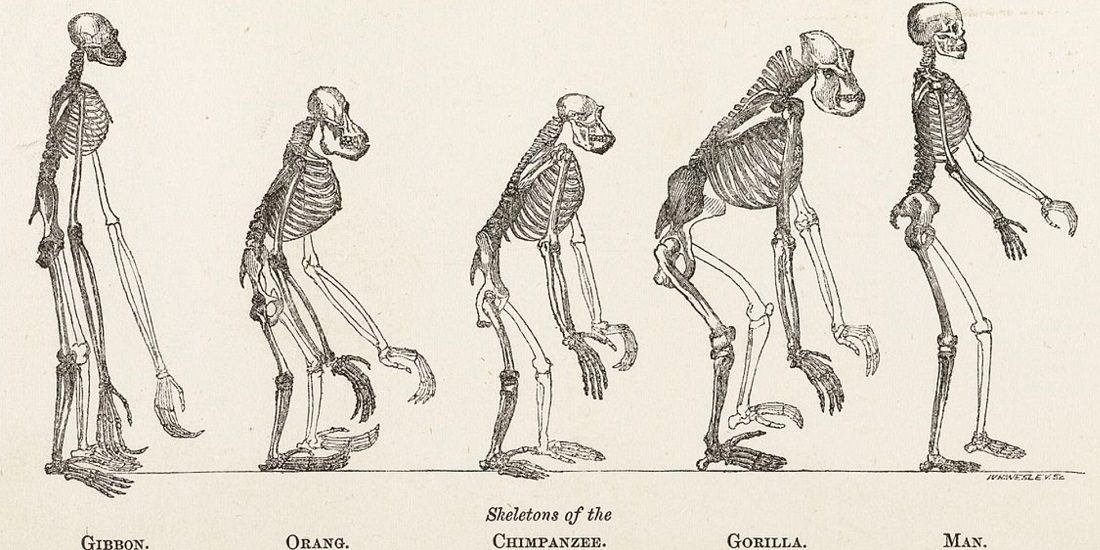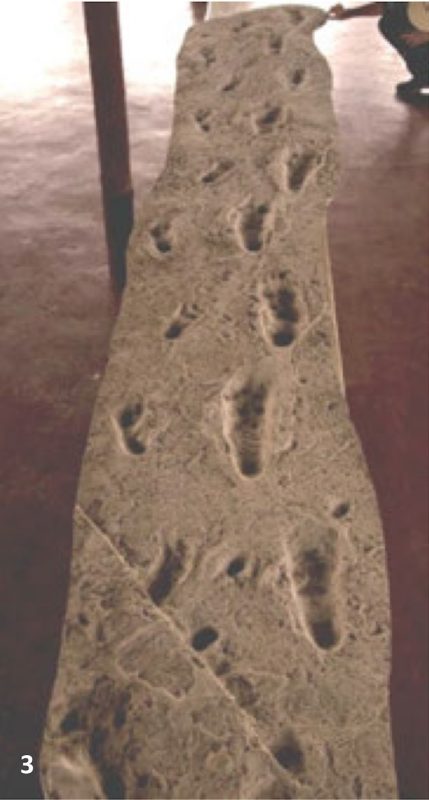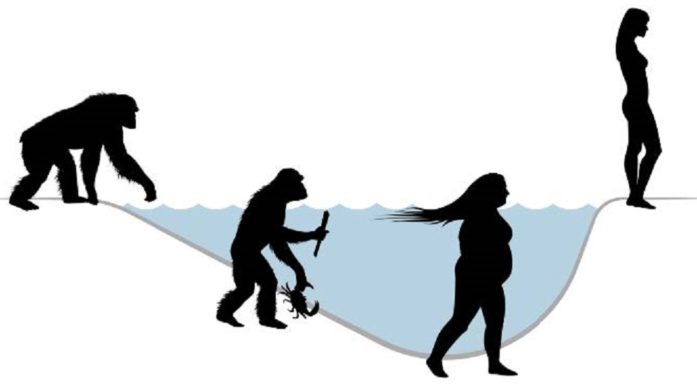Acclaimed fossils might not depict human evolution
Humans may have evolved relatively recently from isolated chimpanzees, without formation of any fossils. This would mean that since the time of Darwin, the missing-link fossils that people have been looking for simply do not exist.
I contend that the most plausible explanation of human evolution is what has been called the aquatic ape theory. In my version of this unorthodox hypothesis, the famed hominin
fossils are not our ancestors. Experts should look at this fossil evidence with more critical eyes.
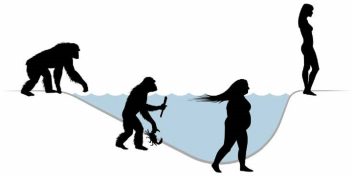
Humans may have originated from a group of
chimpanzees that were isolated for up to 30,000 years on the island of Bioko, Africa. Illustration: Alex Krill
Bioko hypothesis, briefly stated
I explained my version of the aquatic ape theory in a previous article (Gemini July 13, 2017) and only summarize it here. Humans may have originated from a group of
chimpanzees that were isolated for up to 30,000 years on the island of Bioko, Africa. They lived mostly in the sea, on a marine diet with high levels of essential fatty acids for brain
growth. The extreme selection pressures of their semiaquatic environment can explain why our species evolved the striking features that distinguish us from chimpanzees and other apes, such as our large brain, naked skin, external nose, long legs, long scalp hair,
and newborns with weak neck and baby blubber-fat.
No fossils would have formed along the coast of Bioko, because it was an erosional geologic environment without deposition of sediments.
After this speciation event, sea level dropped during the next ice age, and the newly evolved humans could escape to mainland Africa. Modern humans such as Homo sapiens and Homo neanderthalensis then begin appearing in the fossil record. Earlier fossils, those more than about 300,000 years old, are paltry, and do not really show evolution toward the modern human features.
The aquatic ape theory can be demonstrated in many scientific ways. But for the past 57 years, scientists have avoided testing it or treating it as a scientific hypothesis. I think that
is because any serious discussion of this theory would cast doubt on the fossils that are the mainstay of paleoanthropology, the science of human evolution. The hypothesis is
being blocked because of a scientific belief that old fossil fragments are from early human ancestors.
- You might also like: Human evolution in the Sea at Bioko
The dachshund evolved without fossils
For a more familiar example of evolution without fossils, consider the dachshund, a small breed of dog. Dachshunds and all domestic dogs have only recently evolved from wolves,
because of selection pressures applied by humans.
Dachshunds and all domestic dogs have only recently evolved from wolves, because of selection pressures applied by humans. Photo: Martin Olsson and www.pixel.la Wikimedia Commons
There are no fossils that can show the evolution of the dachshund, and there never will be. But the close relationship between
wolf and dachshund can be shown by methods such as genetics and breeding tests.
Now imagine if there were a century-old branch of science entirely dedicated to dachshund evolution, with all attention being given to fossils. In “paleodachshundology” there would be great incentive to find and accept fossil evidence of dachshund ancestors. This science might accept that fossil fragments of foxes, and young wolves, young jackals, and young hyenas, all showed various stages in the evolution of the dachshund. This science would insist that a hypothesis of a recent dachshund speciation from the wolf need not be discussed, because the earlier dachshund ancestors were not wolf-like.
Such a science would be like a religion that is based on wishful thinking and a long history of misunderstanding. But don’t sciences operate under rules that quickly catch and correct
such errors? In paleoanthropology, exceptions are routinely made to some of those scientific rules.
Paleoanthropology has unique challenges and scientific practices
Humans are primates, and fossils of primates are exceedingly rare. No fossil of a gorilla has ever been reported, and only three fossil teeth have ever been attributed to a
chimpanzee. Most of the primate fossils that have been found are only fragments, and any interpretation must involve speculation. There is great incentive to interpret primate fossils to be possible human ancestors.
An example is the recently unveiled fossil “Little Foot” with its gorilla-like skull. The scientists who make these interpretations are obviously biased: they think of themselves as anthropologists, not as primatologists. If a fossil is interpreted as a primate that is not a human ancestor, it will not make for a prestigious publication.
There are far more paleoanthropologists than there are primate fossils or fossil localities. Only a few paleoanthropologists ever find a primate fossil themselves, and they have limited opportunity to study original fossil materials found by others. To protect the fossil evidence and encourage new discoveries, the science of paleoanthropology has adopted practices that are not very scientific. They accept discoveries and interpretations that are not testable or reproducible by impartial scientists. Skeptics and critics can be ignored.
Dealing with them would help the cause of creationism, a lobby with political influence that denies evolution and is always looking for scientific weaknesses.

This hybrid liger is the offspring of a male lion and a female tiger. For some people it is uncomfortable to consider such close biological relationships between living species. Photo: Wikimedia
Here I will show that as a result of their practices, paleoanthropologists in the past have fully believed interpretations that were completely incorrect. Current paleoanthropologists are probably doing the same. Their rejection of the aquatic ape hypothesis should not dissuade geneticists, anatomists, physiologists, and evolutionary biologists from using it and testing it.
The science of paleoanthropology has benefited from falsification
From 1912 to 1953, the fossil skull of “Piltdown Man” was thought to be a missing link between ape and human. He had a cranium like a human, and a protruding jaw like an
ape. This fossil confirmed the general opinion that the large brain evolved first, followed by other human characteristics.
Unfortunately, Piltdown Man was a hoax. It was the cranium of a long-deceased human, put together with the jaw of an orangutan. The pieces had been intentionally broken and many pieces removed so that the jaw and cranium might seem to fit together. They were stained to look old. Dirt was cemented into the cracks. A long canine tooth was crudely filed down, to make it look more human. Close inspection by a skeptic could have exposed this falsification.
The trickster was Charles Dawson, a British fossil collector. He claimed to have gotten the main pieces from the Piltdown gravel pit, and he hid stone tools, fossil teeth, and fossil
animal bones, to be found during subsequent visits.
His discovery was accepted and promoted by leading scientists in England. They wanted to believe it. A good source of information about this history is the essay Piltdown Revisited in the book The Panda’s Thumb, by Stephen Jay Gould. After Gould published his essay in 1980, many of the other items in Dawson’s collection were also shown to be falsifications.
Piltdown Man generated immense public interest that boosted the science of paleoanthropology. Several hundred scientific papers were published, confirming its
significance in human evolution. It was often mentioned by the media in 1925 during the famous “Scopes monkey trial,” where an American school teacher was accused of
teaching evolution. Fossils were the best way to fight the unscientific belief in creationism.
When people or organizations are desperate, ambitious, or enthusiastic, they will do and believe what is demanded to survive, achieve, and contribute.
Paleoanthropology desperately wanted a missing link. Dawson wanted to be elected to the Royal Society. The three British experts, Arthur Smith Woodward, Grafton Elliot Smith, and Arthur Keith, enthusiastically believed in what they were claiming. They received British knighthood, largely as a result of this contribution to science and the scientific status of England.
The article continues under the photo.

Eoanthropus dawsoni or Piltdown Man. For 41 years, scientists believed this to be a missing link between ape and human. Photo: Wikipedia, BBC
Not every expert accepted the Piltdown Man. Within a few years of its announcement,
three different articles in Nature and Science mentioned professors that considered it to be a mistake. But the three experts who studied it somehow saw human-like features in the jaw, and ape-like features in the cranium. No one today doubts that these were honest
errors in judgment.
It was impossible for any skeptics to prove that a mistake had been made. The fossil material was fragile, and visiting scientists were allowed to see the fossils only briefly, without touching them. Then they could study high quality replicas that had been made.
Without proof, no scientist could dare to suggest that Piltdown Man was an intentional
deception. It is unacceptable in science to make an unproven accusation, and could ruin
the disputer’s own scientific career. Even to disagree was unpopular. Scientists do not become prominent by being killjoys.
Errors can go uncorrected also in modern paleoanthropology
Lack of access to the original material is still a problem in paleoanthropology. In other
sciences, discoveries and results can be reproduced or verified in independent
laboratories. But a particular primate fossil is only found once. Others must trust that the
fragments were found as claimed, that none were planted by a trickster, and none were
intentionally kept hidden.
Primate fossils are so rare that a field team may search for years and have nothing to
show for it. Fossil hunters in remote places are sometimes adventurous risk takers. A
mischief-maker or field-assistant may try a prank, by planting some teeth, bones, or
chipped flint tools, to see if eager scientists will be duped by it. If they are, there will be a
wave of excitement in the science of paleoanthropology. The leading scientist may even be
able to name a new hominin species.
A research team that finds fossils can keep others from studying them, until their own descriptions and conclusions are completed and published. Once they have glued the fragments together to yield a result such as brain size or upright bipedal stance, it is difficult to challenge them. Replicas, photographs, and published results are the material that most paleoanthropologists must work with. Any objection to the exciting results that the original researchers made might appear to be motivated by envy.
In a recent example of outright fraud, anthropology professor Reiner Protsch falsified age
determinations of fossils during his entire 30-year career. It ended in disgrace when he
tried to sell his university’s collection of chimpanzee skeletons. Some of his fossil material
was sent to an independent laboratory that showed his age determinations to be wrong.
Protsch had faked fossil discoveries from remarkable places, in order to make dramatic
new interpretations. A 50-million year old primate fossil Protsch said was from Switzerland was actually from France, where others were already found. A Neanderthal fossil, the “Hanöfersand Man,” he had said to be from a bog in northern Germany was not actually a fossil at all. Neither were two other of his inventions, the “Binshof-Speyer Woman” and the”Paderborn-Sande Man.” Exposure of his deception should have been a lesson to other scientists, but it has rarely been mentioned, except by creationists.
The article continues under the movie. All chimpanzees can walk on two legs.
Bipedal and small-brained primates
To get back to the Piltdown Man: his brain case was confidently said to be 1070 cc. This is considerably larger than modern ape brains (ca. 350-530 cc), but far smaller than a human brain case, which it actually was (about 1500 cc). This honest error is an example of bias, when paleoanthropologists have an agenda for the fossil materials they are interpreting.
We should not assume that brain-size estimations of fossils are impartial or accurate. But paleoanthropologists do assume this.
Paleoanthropologists have no plausible explanation for human encephalization — the evolutionary increase of brain size. All paleoanthropologists seem to agree that human-sized brains appear suddenly in the fossil record with the first Homo sapiens.
In the Bioko model, the large human brain evolved directly from the small chimpanzee brain. The aquatic ape theory explains our remarkable encephalization as the result of marine DHA and other essential fatty acids, that the body cannot make and are necessary for brain growth.
Since brain size did not increase sufficiently before Homo sapiens, paleoanthropologists began to use bipedalism, not encephalization, to be the key feature indicating early human evolution. Many bones in the body could be used to show that an ape was bipedal. So even with scanty fossils, many paleoanthropologists could be involved in the discussions.
It should be remembered, however, that arboreal apes are often bipedal when moving on the ground. YouTube videos show how gibbons walk and run like humans. The
domesticated chimpanzee “Oliver” routinely walked comfortably in a fully upright position, leading some people to claim that he was a hybrid humanzee. A genetics test showed that he was not.
All chimpanzees can walk on two legs when carrying something, and must do so when moving about in waist-deep water. In the aquatic ape theory, apes became fully bipedal and long-legged after thousands of years, where the most successful individuals were better at walking and collecting food in waist-deep water.
The article continues under the photo.
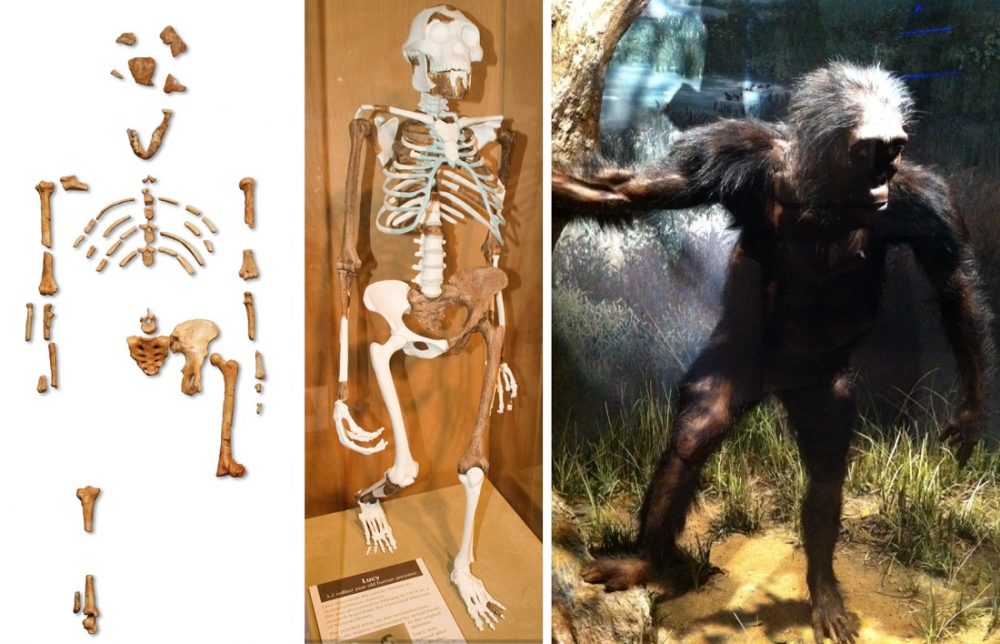
Lucy was a remarkably complete skeleton of an Australopithecus. Specialists were certain that it had a small brain case, and was bipedal. Here are replicas of the bone fragments (left), a model of the skeleton (center), and a model of Lucy herself (right). All photos: Wikipedia
Lucy skeleton 1974
The emphasis on bipedalism became well known to the public by the sensational fossil Lucy in 1974.
Lucy was an Australopithecus, about one meter tall and about 3.2 million years old. The skeleton was said to be 40% complete, which made it by far the most complete early human ancestor.
The bone fragments convinced specialists that Lucy was bipedal with an upright posture. No foot bones or hand bones were known from Lucy or from other Australopithecus. But Lucy was assumed to have had human-like feet.
Laetoli footprints 1978
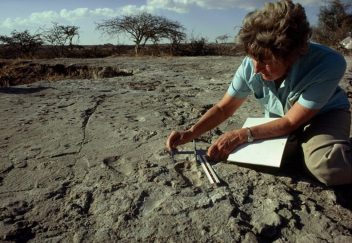
Mary Leakey with the Laetoli footprints in
1979. Photograph by Robert I. M. Campbell,
National Geographic Creative, https://
www.nationalgeographic.com.au/history/
newfound-footprints-stir-debate-over-ourancestors-
sex-lives.aspx
The next major breakthrough came just a few years after Lucy, when a team led by Mary Leakey found footprints of three bipedal individuals (one apparently walking exactly in the track of another) at the site known as Laetoli. The footprints were presumably made by Australopithecus, thus confirming that it was bipedal and had human-like feet.
There are thousands of animal footprints preserved in this layer of rock, including antelopes, hares, giraffes, rhinoceroses, horses, pigs, elephants, birds, and insects.
Geologists know that fossil footprints are usually found in sedimentary rock, which cannot be dated, because the mineral grains in the rock are older than the rock itself. The grains can be millions of years older.
But geology professor Richard L. Hay, working with Leakey, claimed that this layer with footprints was a volcanic ash-fall tuff — lava mineral grains and dust with a remarkable calcareous composition, that had fallen like fresh snow from a volcano 25 kilometers away. Thus, Hay could provide mineral grains of mica to a colleague who specialized in geochronology. It was determined that the mica, and therefore the footprints, were 3.6 million years old.
It is a unique geological interpretation that an ash-fall layer could be perfectly horizontal, and have hundreds of different animals walking on it soon after it fell. Even more
remarkable, is the fact that there are at least 18 similarly thin layers, and at least 9 of them show animal footprints. Hay interpreted each layer to be a separate volcanic eruption. If
these were ash-fall tuffs, I would expect some layers to be considerably thicker, and the layers ought to contain skeletons of animals that were overwhelmed by volcanic ash in the
air. No fossil bones were found in the layers.
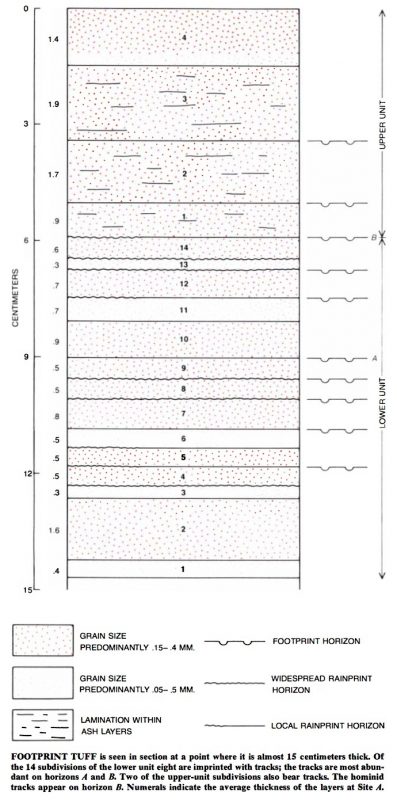
Description of the Laetoli tuffs, from “The Fossil
Footprints of Laetoli” by Hay and Leakey in Scientific
American in 1982.
A standard geological explanation for such a series of thin calcareous layers with footprints would be that this was the edge of a wide shallow lake in an arid climate. Hundreds of animals gathered near the precious water, making footprints in the wet mud.
When it dried and hardened, the footprints were preserved. Then, in the next wet season, the lake level rose and the water brought in more volcanic sediment with old mineral grains, that covered the hardened tracks, making a soft layer suitable for new tracks.
If they are lake sediments, they could contain volcanic ash and minerals that are 3.6 m.y., while the footprints themselves could be as little as a few hundred thousand years old. The
sedimentary layers seem young, as they are perfectly horizontal and not yet tilted in this geologically active rift zone. The footprints could be Homo sapiens, rather than Australopithecus. These are obvious hypotheses to a geologist, but were not discussed by Hay and the others.
An impartial geologist would have little to gain and much to risk by challenging the 3.6 m.y. ash-fall interpretation of the Laetoli layers. A debate about this would play right into the hands of creationists, who claim that fossil evidence is routinely misinterpreted.
In any case, an independent scientist would not be allowed to publish a challenge to an established interpretation, without first conducting new field work at the site. That would be extremely difficult, not only because of the remote African location, but because the paleoanthropologists made their evidence inaccessible, as they so often do.
The Laetoli footprints were studied in 1977 and 1978 by Leakey, Hay, and others.
Descriptions, photographs, and a high quality cast of the bipedal prints were made. Then in 1979, before the results were published, the surface was buried. The layer was covered
by fertile soil, and then large volcanic boulders were placed over the area with the bipedal track. Apparently this was done to keep creationists or vandals from damaging it.
Unfortunately, it also kept independent geologists from looking for dry-lake sedimentary features, or for collecting samples for chemical analysis and microscope study of the mica
and other mineral grains.
The protection efforts at Laetoli have been documented by the Getty Conservation Institute (GCI). Parts of the bipedal track were opened again briefly in 1995-1996. The footprints were found to be badly damaged by soil that had been placed directly on the tuff layer. Pebbles were imbedded in the tuff, and had to be picked away. Acacia trees up to two meters tall had grown above the footprint layer, and their roots had caused considerable damage. The layer was cleaned and photographed to document the damage, and then covered over again, this time with a mat of textile beneath the dirt and boulders.
Again in 2011, in a project that lasted only 11 days, a few of the bipedal prints were reopened and shown to dignitaries, and then reburied. The stripe of dark volcanic boulders is visible on satellite photos of Google Maps.
In 2015, a few new bipedal footprints were found about 150 meters south of the covered track (see Masao et al. in 2016.) I am not in doubt that the prints are real.
The article continues under the photo.

The locality covered by soil, grass, and boulders, before being briefly opened in February 2011. Photo: Getty Conservation Institute
Nariokotome (Turkana) skeleton 1984
In 1984 came another breakthrough, made by a research team led by Richard Leakey. They used five field seasons in the valley of the Nariokotome River near Lake Turkana, to
collect numerous bone fragments from 1,500 cubic meters of sediments. They assembled a spectacular skeleton, popularly referred to as the Nariokotome skeleton or Turkana boy.
It is the most complete early human ancestor in existence, as it includes 108 of the 206 bones of the body. It is thought to be Homo erectus, or perhaps Homo ergaster. There is
little agreement about species identifications, because the fossil material from other places is too scanty and varied to agree which species are the same.
The skull of Turkana boy was assembled from about 70 pieces, and many were missing. The brain case is said to be about 900 cc, and the age about 1.5 million years. The bones
are said to show bipedality, and everyone assumes that the boy had human-like feet. However, the assembled skeleton has neither foot bones nor hand bones.
In the scientific descriptions that were published in 1993 (The Nariokotome Homo erectus skeleton), Alan Walker and Richard Leakey mentioned that a possible metatarsal (foot bone) was found “but it has some peculiar features and is from a part of the site that has yielded only questionable pieces.” The fossil collectors found fragments of many animals in the large volume of sediments.
Did they perhaps find hand bones or foot bones that suggested an arboreal lifestyle, and therefore could not belong to this skeleton?
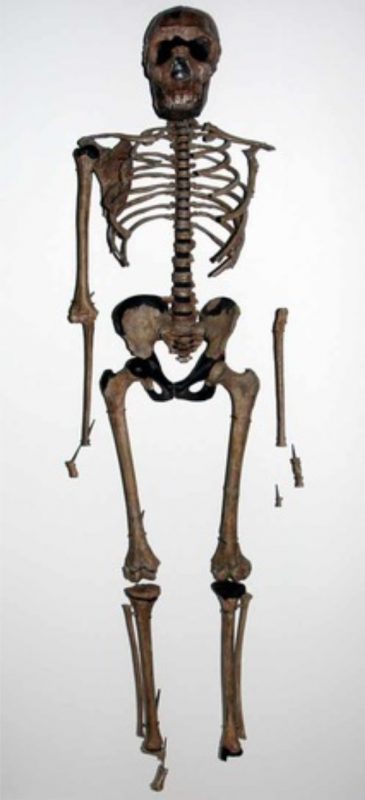
Turkana boy skeleton, replica. Peabody Museum, Yale University. Except for hand and foot bones, the skeleton is nearly complete. https://collections.peabody.yale.edu/search/
Record/YPM-ANT-268045
Paleoanthropologists have an explanation for the general lack of foot bones in ancient hominins. Bernard Wood, author of Human Evolution – A Very Short Introduction wrote:
“Leopards like to chew on the hands and feet of monkeys and, if extinct large carnivores had similar preferences, then these parts of hominins would be in short supply as fossils.”
This explanation would probably not apply to fossils found in a cave, such as the recently unveiled “Little Foot” skeleton, currently the most complete Australopithecus. A few humanlike foot fragments were discovered unexpectedly in a museum drawer. Then the other bones were found and excavated from the Sterkfontein cave.
Many monkey bones are known from that cave. The leg bones of “Little Foot” were found together with the arm bone of a monkey, while the arm bones and other parts used in constructing the “Little Foot” skeleton were excavated from further away.
Paleoanthropologists believe that these various bones comprise a single skeleton, an ancestor to humans, and unrelated to the monkeys.
Weaknesses in a scientific paradigm should be openly discussed
The aquatic ape theory is denied by paleoanthropologists, partly because it holds that human features evolved all at the same time in a single speciation event.
Paleoanthropologists contend that human bipedalism evolved at least two million years earlier than human encephalization. The Laetoli footprints and the Nariokotome small-brained bipedal skeleton are the most often cited proof of this interpretation. But even the best hominin evidence is problematic.
It is fair for paleoanthropologists to call the aquatic ape theory “speculative,” but the same should be said of the theories of human evolution that are currently being promoted. The fossil evidence regarding human evolution is neither reproducible nor reliable. And since paleoanthropologists cannot explain what caused humans to evolve naked skin, bipedalism, large brain, and other human features, creationists can push the non-scientific idea that this unique evolutionary path was the result of “Intelligent Design.”
Lucy, Laetoli footprints, Nariokotome skeleton, and Little Foot skeleton are currently the most highly regarded fossils in paleoanthropology.
Earlier key fossils were Java Man, Piltdown Man, and Peking Man. Java Man, announced in 1891, is the type fossil of Homo erectus. It consisted of a humanlike tooth and thighbone, and a gibbon-like skull cap, that were not found together. The brain size was said to be 700 cc in 1891, but was increased to 900 cc in 1892. Both of these size determinations are much larger than any gibbon.
Additional pieces thought to belong to this species were purchased from local people who could not document where the pieces had been found. Some of the pieces had been broken before being sold, because the sellers were paid by the number of pieces. The interpretations are speculative and not highly regarded today.
Peking Man was a missing-link sensation in the 1930s. The fossils consisted of stone tools, as well as skull and jaw fragments from as many as 15 individuals. They were found
loose in a cave. High quality casts and scientific descriptions were made. But somehow, all the original material disappeared in 1941, and has never been found.
Most paleoanthropologists currently assign both Java Man and Peking Man to Homo erectus, but this term probably includes several species.
When one reads paleoanthropologic descriptions with a measure of skepticism, one can find problems with all the discoveries. Most of the fossils could be fragments of unrelated apes. From genetics, it now seems that neither Java Man nor Peking Man could be ancestral to living humans.
It is now proven by mitochondrial DNA and Y-chromosomal DNA, to nearly
everyone’s satisfaction, that all living humans descended from a small population that lived in Africa about 200,000 years ago. The common matrilineal ancestor is often called
Mitochondrial Eve and the patrilineal ancestor is called Y-chromosomal Adam. The last common ancestor of chimpanzees apparently lived a few million years ago, and human
mitochondrial DNA falls within the wide range of variation of chimpanzee mitochondrial DNA.
In my version of the aquatic ape theory, Homo sapiens speciated on the island Bioko directly from a group of isolated chimpanzees (Pan troglodytes), rather than from missing
links such as Paranthropus, Ardipithecus, Australopithecus, Homo habilis, Homo rudolfensis, Homo ergaster, Homo erectus, Homo naledi, and Eoanthropus dawsoni.
Mitochondrial Eve and Y-chromosomal Adam might have lived on Bioko, or more likely on nearby Africa, soon after the speciation.
The aquatic ape theory will never be able to point to a dramatic fossil discovery, which typically launches new evolution theories. But such fossils, although exciting, are not as certain as most people assume.
I hope that anatomists, physiologists, evolutionary biologists, and especially geneticists will not be put off by the fossil-based denial of the aquatic ape theory, but will test it and discuss the results in scientific journals.
A PDF of this article may be found here. Acclaimed fossils might not depict human evolution
